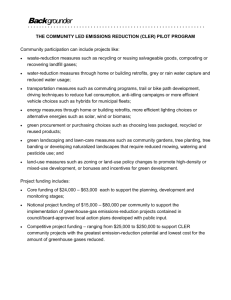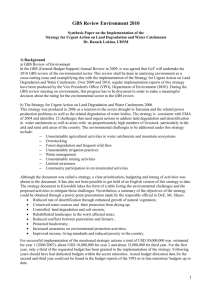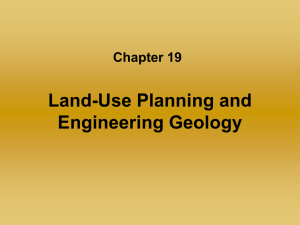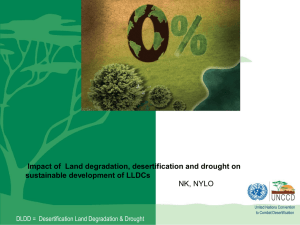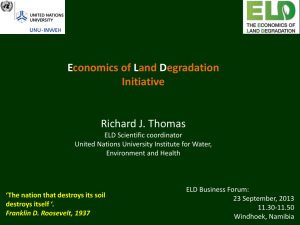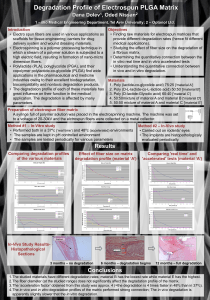Progress in Integrated Planning and Management of Land Resources
advertisement
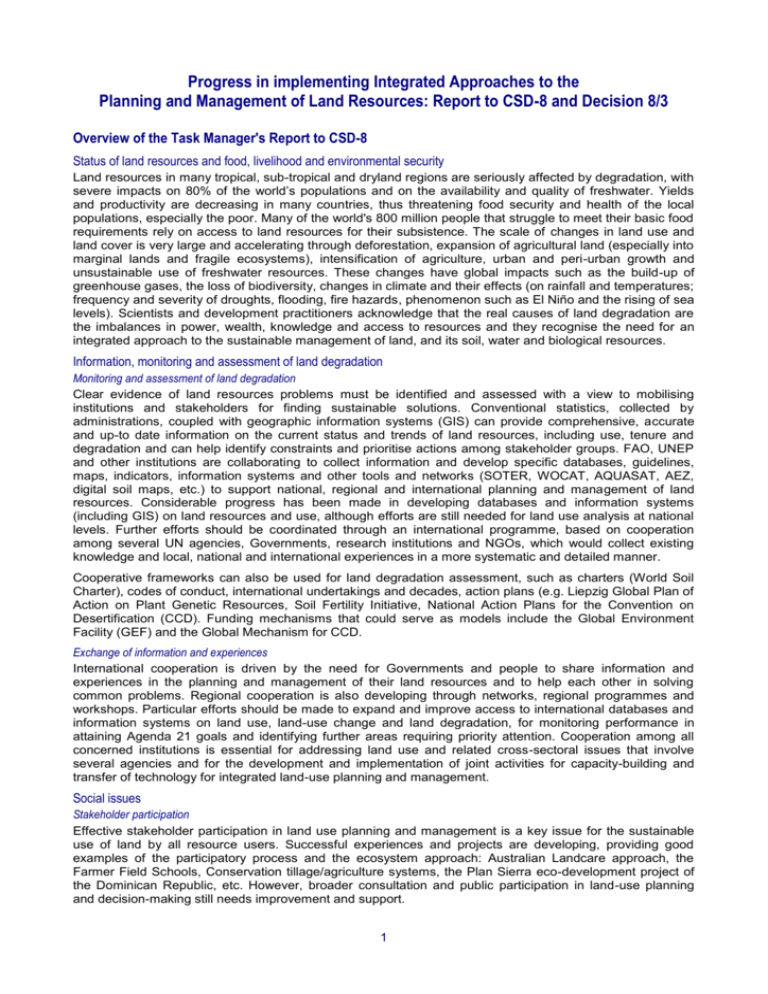
Progress in implementing Integrated Approaches to the Planning and Management of Land Resources: Report to CSD-8 and Decision 8/3 Overview of the Task Manager's Report to CSD-8 Status of land resources and food, livelihood and environmental security Land resources in many tropical, sub-tropical and dryland regions are seriously affected by degradation, with severe impacts on 80% of the world’s populations and on the availability and quality of freshwater. Yields and productivity are decreasing in many countries, thus threatening food security and health of the local populations, especially the poor. Many of the world's 800 million people that struggle to meet their basic food requirements rely on access to land resources for their subsistence. The scale of changes in land use and land cover is very large and accelerating through deforestation, expansion of agricultural land (especially into marginal lands and fragile ecosystems), intensification of agriculture, urban and peri-urban growth and unsustainable use of freshwater resources. These changes have global impacts such as the build-up of greenhouse gases, the loss of biodiversity, changes in climate and their effects (on rainfall and temperatures; frequency and severity of droughts, flooding, fire hazards, phenomenon such as El Niño and the rising of sea levels). Scientists and development practitioners acknowledge that the real causes of land degradation are the imbalances in power, wealth, knowledge and access to resources and they recognise the need for an integrated approach to the sustainable management of land, and its soil, water and biological resources. Information, monitoring and assessment of land degradation Monitoring and assessment of land degradation Clear evidence of land resources problems must be identified and assessed with a view to mobilising institutions and stakeholders for finding sustainable solutions. Conventional statistics, collected by administrations, coupled with geographic information systems (GIS) can provide comprehensive, accurate and up-to date information on the current status and trends of land resources, including use, tenure and degradation and can help identify constraints and prioritise actions among stakeholder groups. FAO, UNEP and other institutions are collaborating to collect information and develop specific databases, guidelines, maps, indicators, information systems and other tools and networks (SOTER, WOCAT, AQUASAT, AEZ, digital soil maps, etc.) to support national, regional and international planning and management of land resources. Considerable progress has been made in developing databases and information systems (including GIS) on land resources and use, although efforts are still needed for land use analysis at national levels. Further efforts should be coordinated through an international programme, based on cooperation among several UN agencies, Governments, research institutions and NGOs, which would collect existing knowledge and local, national and international experiences in a more systematic and detailed manner. Cooperative frameworks can also be used for land degradation assessment, such as charters (World Soil Charter), codes of conduct, international undertakings and decades, action plans (e.g. Liepzig Global Plan of Action on Plant Genetic Resources, Soil Fertility Initiative, National Action Plans for the Convention on Desertification (CCD). Funding mechanisms that could serve as models include the Global Environment Facility (GEF) and the Global Mechanism for CCD. Exchange of information and experiences International cooperation is driven by the need for Governments and people to share information and experiences in the planning and management of their land resources and to help each other in solving common problems. Regional cooperation is also developing through networks, regional programmes and workshops. Particular efforts should be made to expand and improve access to international databases and information systems on land use, land-use change and land degradation, for monitoring performance in attaining Agenda 21 goals and identifying further areas requiring priority attention. Cooperation among all concerned institutions is essential for addressing land use and related cross-sectoral issues that involve several agencies and for the development and implementation of joint activities for capacity-building and transfer of technology for integrated land-use planning and management. Social issues Stakeholder participation Effective stakeholder participation in land use planning and management is a key issue for the sustainable use of land by all resource users. Successful experiences and projects are developing, providing good examples of the participatory process and the ecosystem approach: Australian Landcare approach, the Farmer Field Schools, Conservation tillage/agriculture systems, the Plan Sierra eco-development project of the Dominican Republic, etc. However, broader consultation and public participation in land-use planning and decision-making still needs improvement and support. 1 Capacity building Support is provided by UN agencies and international partners in developing tools and capacities for integrated approaches to ecosystems and land-use systems, such as river basins, wetlands, mangroves and biosphere reserves. Other capacity-building programmes and initiatives focus on issues such as land vulnerability, food insecurity assessment, drought mitigation, and environmental accounting. Capacitybuilding in policy-making, land-use management, land and water information, monitoring and assessment is still needed at all levels to address critical problems of land degradation, including prevention and rehabilitation. Policy issues Access to land and land tenure issues The review of property rights, land tenure systems and land markets must take into account private, public, informal and indigenous regimes to ensure equal access to land and the security of land tenure, in particular for disadvantaged groups, including women, the poor and indigenous people. The challenge is to ensure legal and social rights for traditional “owners” and users of areas with various forms of communal tenure. For the former centrally-planned economies, land registries and property cadastres also have to be created or reestablished. Moreover, changes in land tenure may alter the behaviour of individuals and local communities, leading to land degradation – for example, overgrazing following the settlement of nomads – and overexploitation when communally managed land become public lands with free access. Trade liberalisation and globalisation may also create problems in land markets (i.e. local/national interests vis-à-vis those of foreign buyers and investors), which may increase the need for international cooperation and require further study of the possible impacts. National land use strategies, plans, programmes and policies International agreements and conventions have stimulated international and national policies and programmes promoting integrated land-use planning and management. Several developed countries have adopted or are developing comprehensive land use plans and programmes (Japan, Australia, Europe...). In many developing countries, National Action Plans and strategies have been prepared for the CCD and the CBD (less advanced). However, financial resources are often missing for the implementation of these plans. Synergy between the various conventions (CCD, CBD, FCCC, wetlands), national programmes, and policies is encouraged so that their implementation can provide greater benefit, increasing effectiveness and saving resources. Nevertheless, in many countries, policies remain fragmented and incomplete, or can hardly be implemented, because of institutional barriers, conflicting mandates and the prioritisation of economic over social and environmental goals, and of short-term development over long-term goals. A number of countries have formulated land-use strategies as part of their national Agenda 21 and environmental action plans, often with the support of international organisations. The scope has expanded from a focus on delimitation of areas for protection (nature reserves), critical watersheds and other critical areas or pollution problems, to encompass sustainable land-use plans in a wider geographical and longer-term perspective. The decentralisation and devolution of power in land-use planning and management is developing but is often a source of conflict among the local, regional and national institutions involved. Clear responsibilities still need to be assigned, at all levels, for various aspects of land-use planning and management, and mechanisms developed to overcome institutional barriers between agencies at central and local levels. Areas of particular attention Further international cooperative efforts are needed in capacity building, transfer of technology, research and development, and investments to address critical problems of land degradation, including both prevention and rehabilitation. Comprehensive strategies for sustainable land use now address agricultural lands, forest lands, urban and peri-urban areas, problems of degradation, and land and water use conflicts. Nevertheless, greater efforts should be oriented towards sustainable agriculture and degradation or desertification, as agriculture remains the major user of land and water resources and biodiversity to meet the increasing demand for food and other products. Areas still requiring particular attention are: agricultural lands; forest lands; mountain lands; desert margins, arid and semi-arid areas; protected areas; urban and peri-urban lands. Land use management, and forest management in particular, is an important issue for the implementation of the Convention on Climate Change (UNFCCC) and the Kyoto Protocol as it can have great impact on carbon sequestration. Waste management is receiving growing attention from local communities and governments, but remains a major cause of land degradation in many countries. Decisionmaking mechanisms for integrated approaches for land resources planning and management are still needed, especially in peri-urban and rural areas. Detailed analysis of specific issues was provided in 4 addenda to the main report: Addendum 1 - Integrated planning and management of land resources: combating deforestation. Addendum 2 - Integrated planning and management of land resources: combating desertification and drought. Addendum 3 - Integrated planning and management of land resources: sustainable mountain development. 2 Addendum 4 - Integrated planning and management of land resources: conservation of biological diversity. Outcome of CSD-8 Decision 8/3 of the CSD insists on the importance of addressing Land Planning and Management through a holistic approach such as ecosystem-based management. Other major issues raised are access and rights to land, water and other natural resources, as well as the need for national and local measures to protect critical natural resources. It has also been recognised that social and health aspects of land-use systems should be integrated in the overall planning process. Priorities have been highlighted for future work: Prevention and/or mitigation of land degradation: there is an urgent need for appropriate policies, institutional frameworks and measures to change production/consumption systems into sustainable ones in order to combat land degradation, desertification, deforestation and loss of biodiversity, and therefore improve food security, alleviate poverty and mitigate the effects of climate change on populations. Access to land and security of tenure: equal access and the security of land tenure including for women, poor people, indigenous and local communities, have to be guaranteed by national and local policies and laws. Adequate land administration systems must also be developed to support sustainable land tenure. The participatory approach is strongly encouraged for land tenure reform processes and for the planning and management of land resources. Critical sectors and issues are highlighted, with specific measures to take for: Biodiversity: recall on the importance of (a) areas containing high concentrations of biological diversity; (b) threatened ecosystems; and (c) species at risk. Call for ratification and implementation of the Cartagena Protocol on Biosafety of the CBD and vigilance on the use of biotechnologies because of possible risks for health and environment. Forests: implementation of the Intergovernmental Panel and Forum on Forests (IPF/IFF) to promote the management, conservation and sustainable development of forests. Drylands: appropriate measures to combat drought and desertification and for the sustainable use of fragile land resources and water resources in drylands. Particular attention is required for areas with high population pressures and drought. Mountain areas: specific measures and particular attention to the economic balance of these areas to ensure a sustainable management of mountainous areas and watersheds. Wetlands and coastal zones: conservation of wetlands and particular attention to coastal areas in relation to fragile marine ecosystems. Natural disasters: design and implementation of warning systems and intervention plans, as well as short to long-term strategies for disaster management. National, regional and international relief and remedial support is needed. Rural-urban and land management interactions: the development of urban areas, including transportation, housing, infrastructure and urban/peri-urban agriculture need careful management to ensure its sustainability. Particular attention is required for the impact on the living conditions of the poorest and interactions with rural areas. Stakeholder participation is strongly encouraged in rural and urban land-use planning and management. Governments are urged to develop and strengthen capacity and institutional framework for effective participation of all stakeholders, including women, land workers, poor people, indigenous and local communities. The responsibilities of local authorities and stakeholders in sustainable land use should be recognised, and local governments and communities empowered for the formulation and implementation of appropriate practices, through financial and technical support. Rehabilitation of mining areas: social, economic and environmental impacts of mineral extraction and metal production must be considered and strategies must be implemented for the rehabilitation of land degraded by mining. International cooperation, including that for capacity building, information sharing and technology transfer is strongly encouraged, in particular to support the implementation of Agenda 21. Access to upto-date information, appropriate technologies and support systems (e.g. GIS and GPS) should be improved in developing countries with the support of the international community and developed countries. The development of land-use indicators and monitoring systems is encouraged to assess progress in the implementation of programmes for sustainable development. All countries are urged to sign and ratify the Kyoto Protocol and the 3 UN Conventions (CCD, CBD and FCCC). The need for regional and international cooperation and support (technical and financial) is highlighted for each issue. 3
